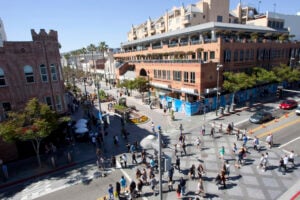 The City Council finally did something right.
The City Council finally did something right.
During last Tuesday's meeting, they voted against studying environmental impacts of new buildings over 84 feet in Downtown.
Officials had asked for approval to study buildings as high as 135 feet at eight designated "opportunity sites" mentioned in the proposed Downtown Specific Plan (DSP).
The DSP (when approved by City Council) will mandate new standards for new building heights, sizes and shapes in the Downtown area from Lincoln Boulevard to Ocean Avenue and Wilshire Boulevard to the I-10 Freeway.
If an 84 feet maximum height limit is eventually adopted, developers desiring to build higher — such as the developers of the proposed renovated Fairmont, Frank Gehry's new hotel and new Wyndham hotel on Ocean Avenue — would have to complete their own environmental impact reports (EIR) and be granted a DSP amendment by the City Council. The owners of the Miramar are already working on their EIR.
The three proposed hotel developments contain elements with heights ranging from 195 feet (the Wyndham) to over 300 feet (the Miramar). The proposed height limitation will also impact the proposed 148-foot-tall "Plaza at Santa Monica" bounded by Fourth and Fifth streets and Arizona Avenue on city-owned property.
The council's decision makes sense because anything taller than 84 feet would have to stand on its own merits. Maybe that's why there was not a great deal of opposition to the height limitation by developers.
Lest you think that certain pro-development council members have suddenly turned a new leaf and are listening to the public, be aware that nothing much has changed.
As with all things developmental in Santa Monica, the devil is in the details. Council also voted to increase building density by increasing a building's total usable floor area in relation to its parcel size in most sections of Downtown.
Called a floor area ratio or FAR, it generally determines a building's size and density. Factors such as adding a floor or two of housing within a commercial development would allow for a higher floor area ratio or an overall larger building than could be built without housing. Additional community benefits might also open the door for more size and density bonuses.
Concerned citizens will need to make sure that streets, such as the Third Street Promenade where the prevailing building height is a very comfortable one or two floor floors do not become urban canyons like Lincoln Boulevard is projected to be within the next few years with wall-to-wall, five and six floor housing/retail developments between Wilshire and Olympic boulevards.
By the way, recommended new FAR's will mean that developers can build to 84 feet — the same height as the Water Garden — virtually the entire length of Colorado Avenue from Ocean to Lincoln including the Denny's Restaurant site which is now zoned for 45 feet.
Power to the people
Many of you are aware that Southern California Edison (SCE) which supplies electrical power to Santa Monica residents and businesses is looking for a way to pay off a $4.1 billion debt that occurred when it permanently closed its San Onofre nuclear generating plant.
Edison is looking at any all sources of revenue including ratepayers (that's us), stockholders, equipment manufacturers and insurance companies to pick up the tab after problems developed with plumbing in San Onofre's recently replaced steam generating equipment. Edison officials have determined that repairs to keep the plant operating would be too costly.
After decades of paying for nuclear power that promised to be "cheap, safe and would insure a steady and reliable source of cheap energy," we're again being asked to pay for costs that should be borne by SCE's investors.
Edison executives wrote in a media letter that if "a utility asset must be retired before the end of its expected life, the utility recovers from customers its reasonable investment costs." Because San Onofre was shut down more than a decade prematurely, only a portion of San Onofre's costs have been recovered. Now, we're expected to pony up the rest.
Edison will also ask us to invest in replacement generating capacity. With uncertainty over the amount to be recovered, there are no estimates on the size of rate increases Edison will seek.
Estimates are it'll cost an additional $200 from each of Edison's five million residential and business customers to pay off each billion dollars in debt. Ultimately, federal and state agencies such as the California Public Utilities Commission will have to "OK" plans to permanently shutter San Onofre as well as any debt payment scheme.
Ratepayers are not stockholders. We have no say in Edison's management decisions. Because of SCE's monopoly, we must purchase electricity from SCE. We can't go somewhere else. It's like asking us to pay more for tonight's movie ticket because last week's film at the theater bombed.
Isn't Edison management responsible for the problems and oversights at San Onofre? Shouldn't corporate shareholders be required to pay for losses incurred as a result of inept management decisions?
Unfortunately, we're already paying for SCE's poor management. The Los Angeles Times reported Aug. 12, that much of the cost of the debacle has already been paid by customers. "About $2.7 billion in ratepayer money has accumulated in a special Edison decommissioning trust fund as of March 31 …," the Times reported.
We all should keep an eye on this and make sure the California PUC knows that we shouldn't be ripped off by SCE with misdirected future rate increases.
Bill can be reached at mr.bilbau@gmail.com.








